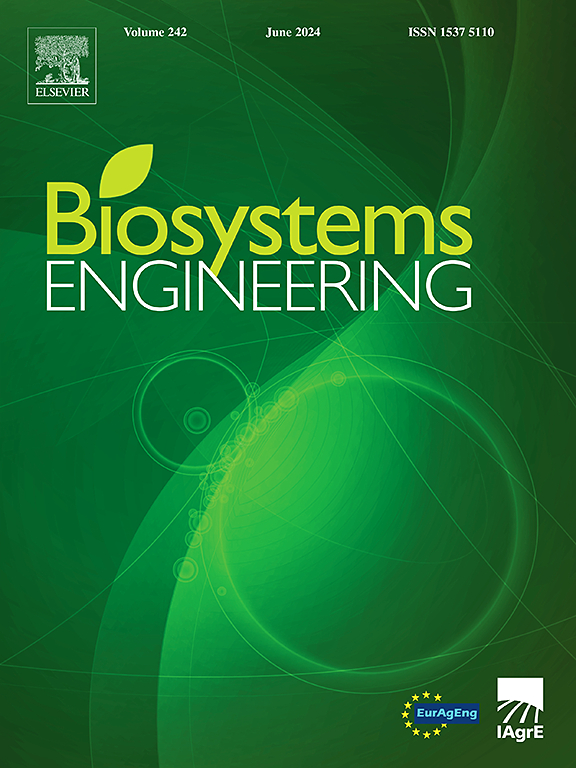Evaluating the influence of double-channel inclined spreading blades on the effect of fertiliser granule spreading: DEM modelling and simulations
IF 5.3
1区 农林科学
Q1 AGRICULTURAL ENGINEERING
引用次数: 0
Abstract
In view of the problems with the widely used single-channel linear fertiliser spreading blade, including obvious operational pulsation, a narrow fertiliser spreading width at low speeds, an irregular overlap of the fertiliser coverage area, and poor fertiliser distribution uniformity at high speeds, a double-channel inclined fertiliser spreading blade structure was designed in this research. Based on the discrete element method (DEM), the mechanism of fertiliser spreading by blades under different blade declination angles, blade inclination angles, disc rotation speeds and machine forward speeds was analysed, and the influences of each factor on the coefficient of variation Cv of fertiliser distribution and the effective width B of fertiliser spreading were analysed and summarised; the best blade fertiliser spreading performance was attained when the blade declination angle and inclination angle were 10° and 14° respectively, the disc rotation speed was 350 rev min−1, and the machine forward speed was 1.3 m s−1. At this moment, the coefficient of variation of the fertiliser distribution Cv was 15.17 %, and the effective width of the fertiliser spreading B was 9 m. In comparison with the initial foliar fertilisation, the Cv was decreased by 35.42 % and the B was increased by 28.57 %. It is shown that the discrete element method can effectively model the process of fertiliser spreading and predict the motion behaviour of fertiliser particles, and it is also shown that the use of this blade in fertiliser spreading machine can effectively improve the quality of fertiliser spreading operation.
评估双通道倾斜散布叶片对肥料颗粒散布效果的影响:DEM建模与模拟
针对目前广泛使用的单通道线性施肥叶片存在操作脉动明显、低速施肥宽度窄、覆盖面积重叠不规则、高速施肥均匀性差等问题,设计了双通道倾斜施肥叶片结构。基于离散元法(DEM),分析了不同叶片倾角、叶片倾角、叶片转速和机器前进速度下叶片施肥机理,分析总结了各因素对施肥变异系数Cv和施肥有效宽度B的影响;叶片倾角和倾斜角分别为10°和14°,圆盘转速为350 rev min−1,机器前进速度为1.3 m s−1时,叶片撒肥性能最佳。此时,施肥分布变异系数Cv为15.17%,施肥有效宽度B为9 m。与初始叶面施肥相比,Cv降低35.42%,B增加28.57%。结果表明,离散元法可以有效地模拟施肥过程,预测肥料颗粒的运动行为,并表明该叶片在施肥机上的使用可以有效地提高施肥作业的质量。
本文章由计算机程序翻译,如有差异,请以英文原文为准。
求助全文
约1分钟内获得全文
求助全文
来源期刊

Biosystems Engineering
农林科学-农业工程
CiteScore
10.60
自引率
7.80%
发文量
239
审稿时长
53 days
期刊介绍:
Biosystems Engineering publishes research in engineering and the physical sciences that represent advances in understanding or modelling of the performance of biological systems for sustainable developments in land use and the environment, agriculture and amenity, bioproduction processes and the food chain. The subject matter of the journal reflects the wide range and interdisciplinary nature of research in engineering for biological systems.
 求助内容:
求助内容: 应助结果提醒方式:
应助结果提醒方式:


